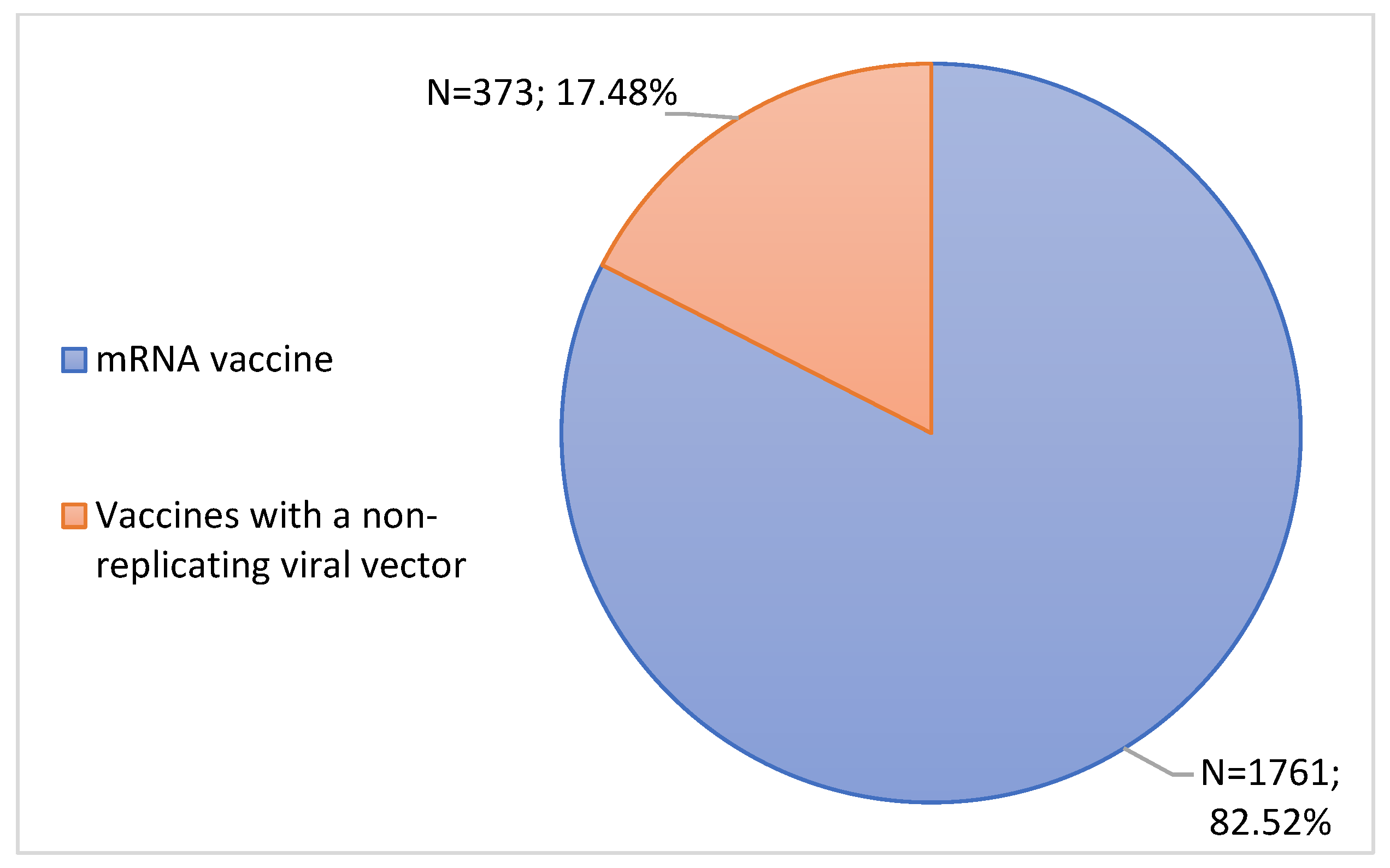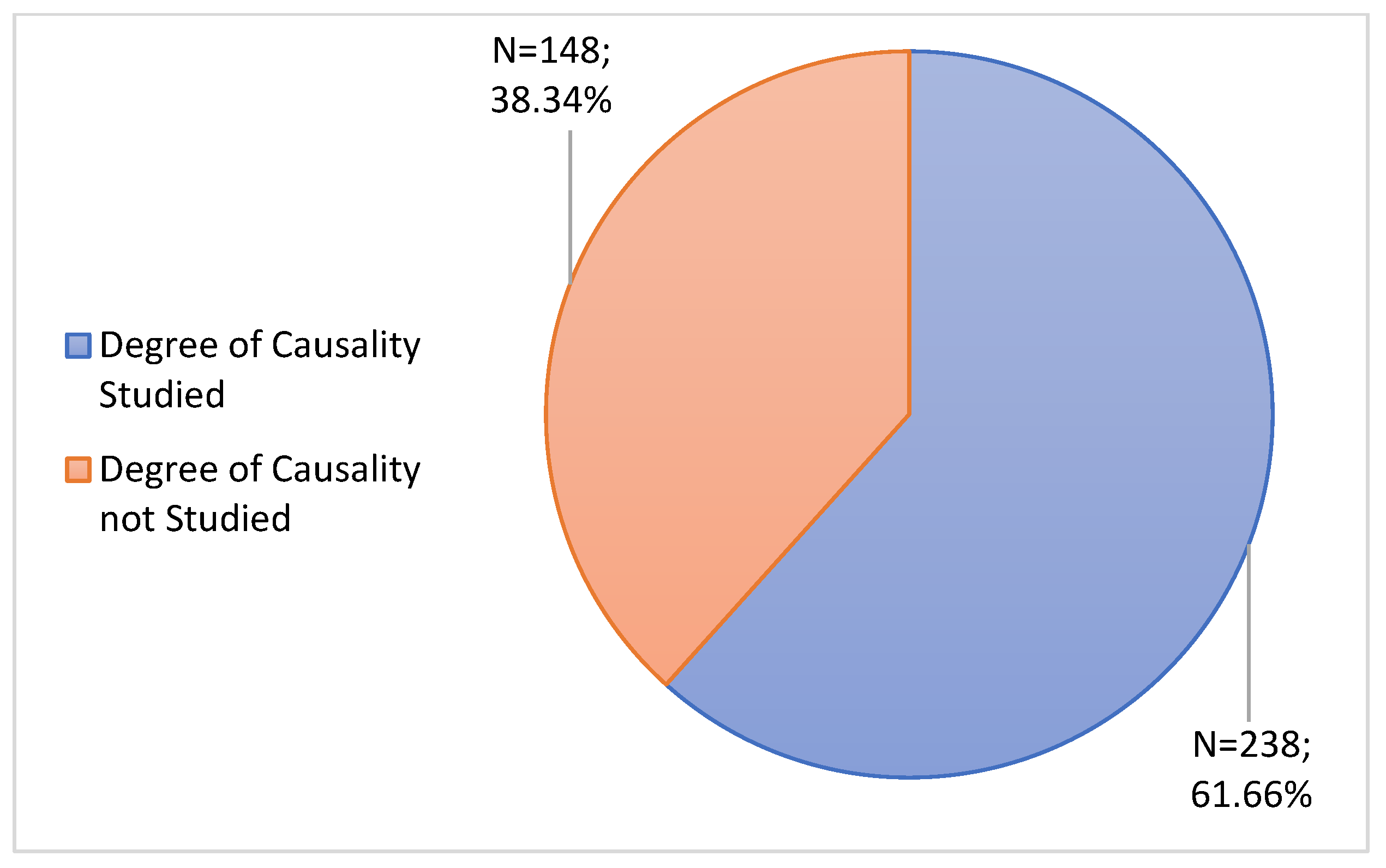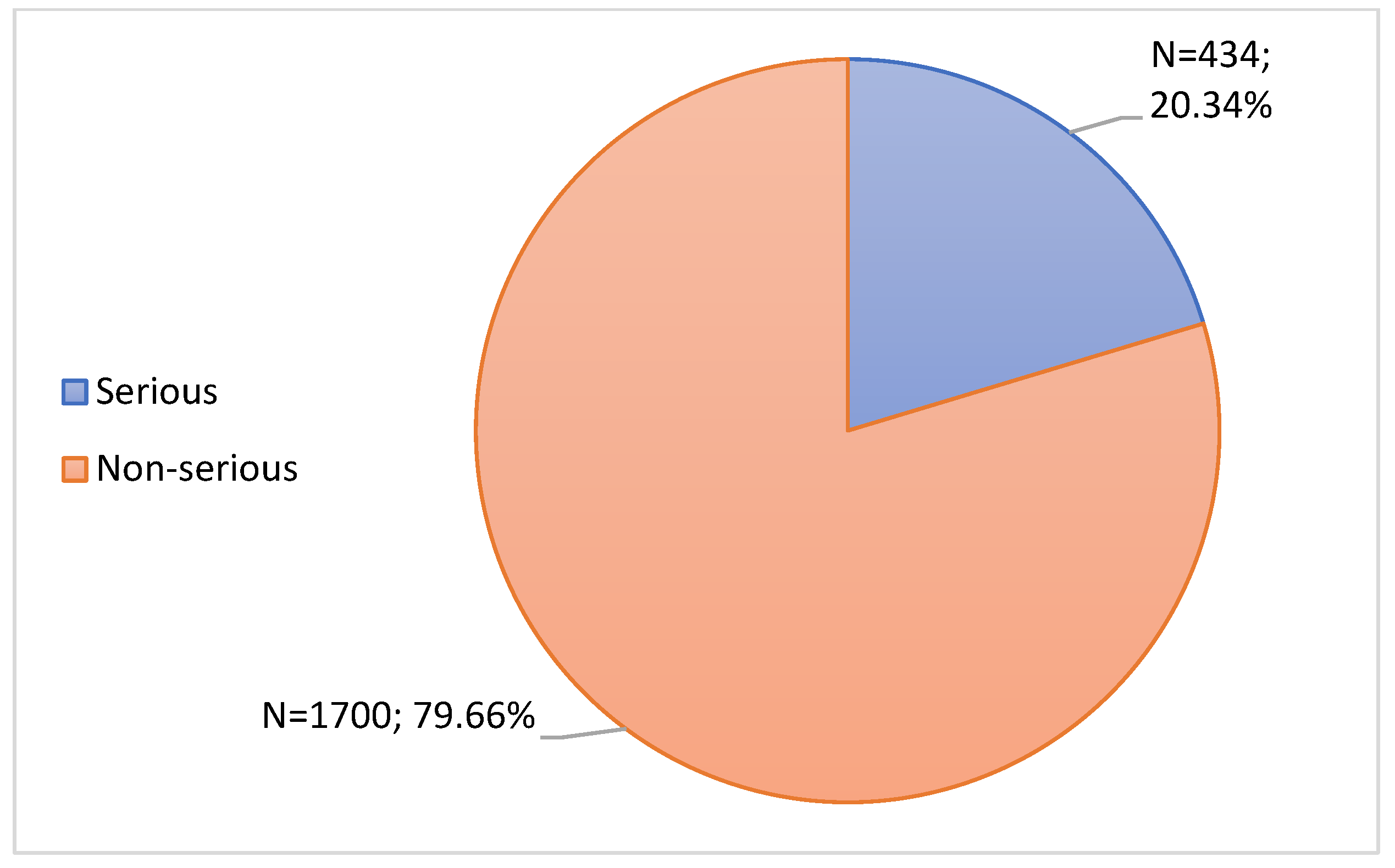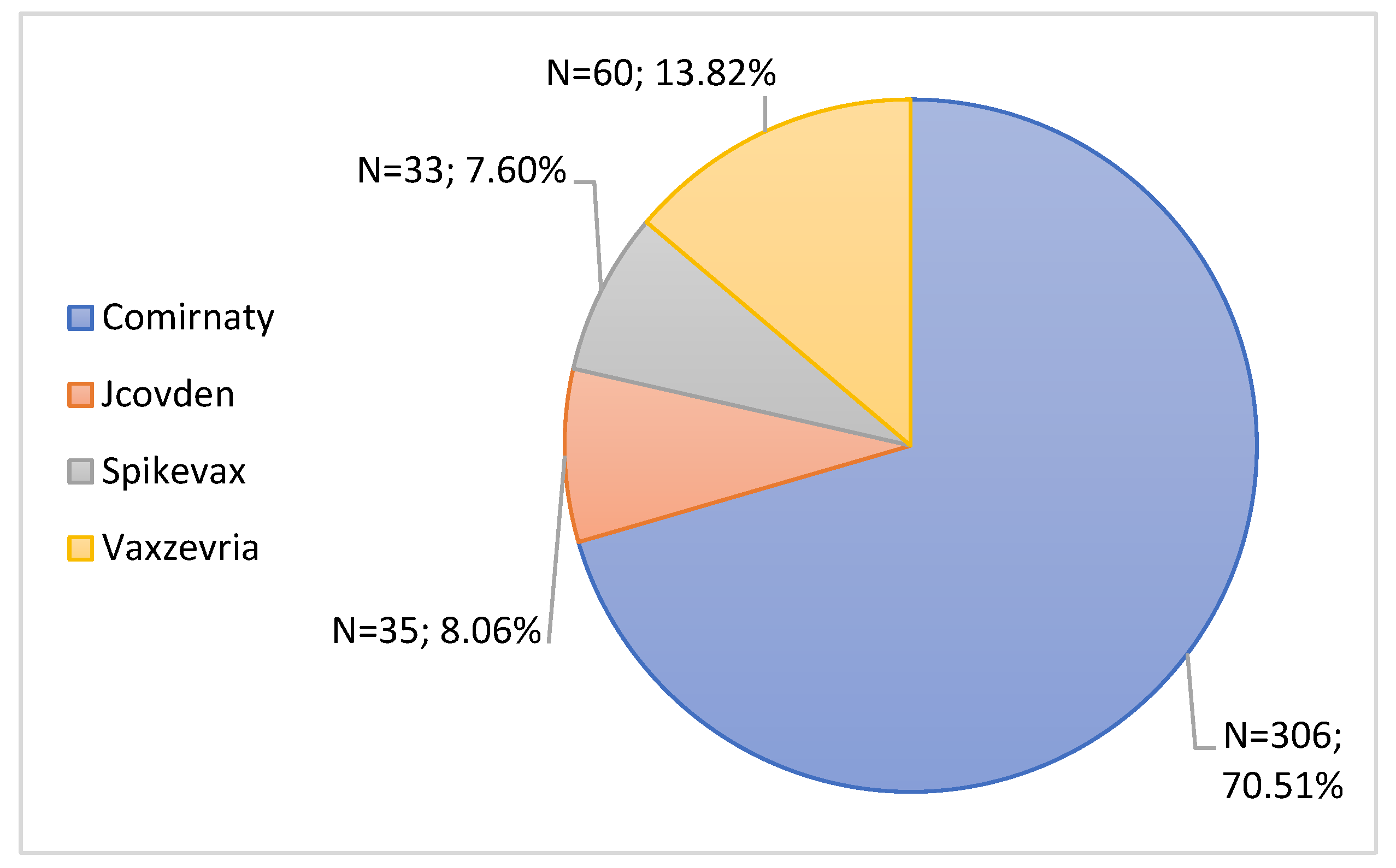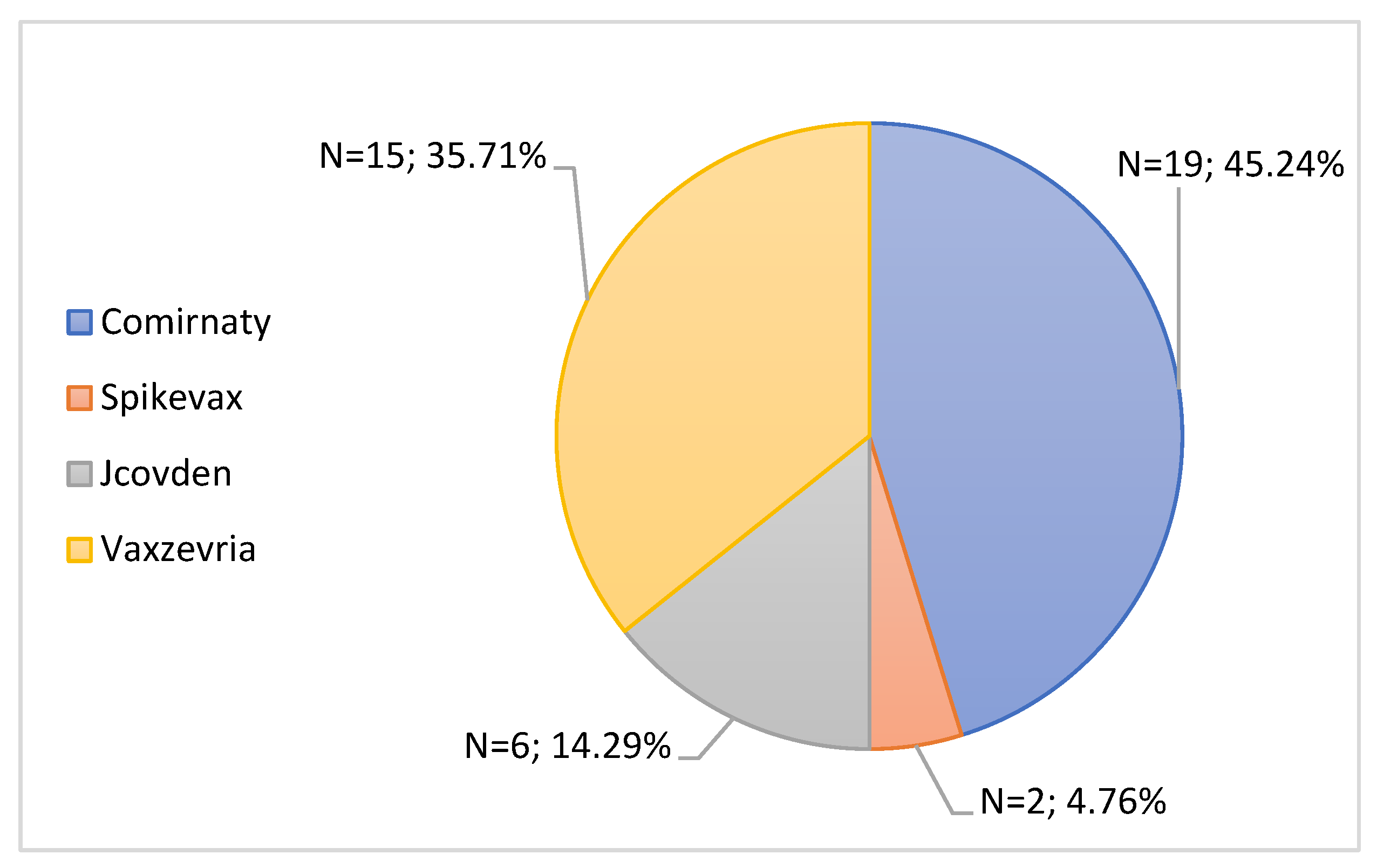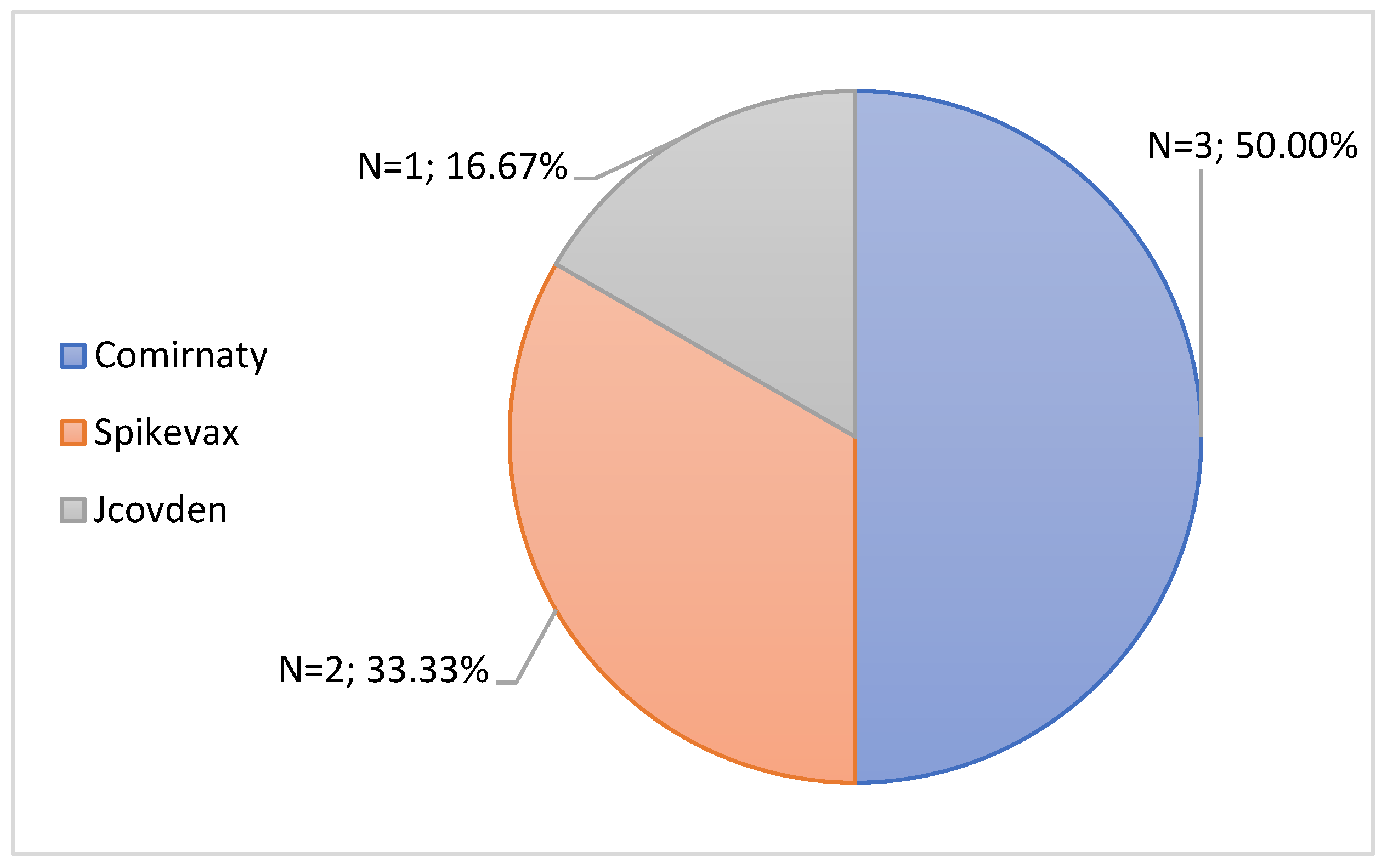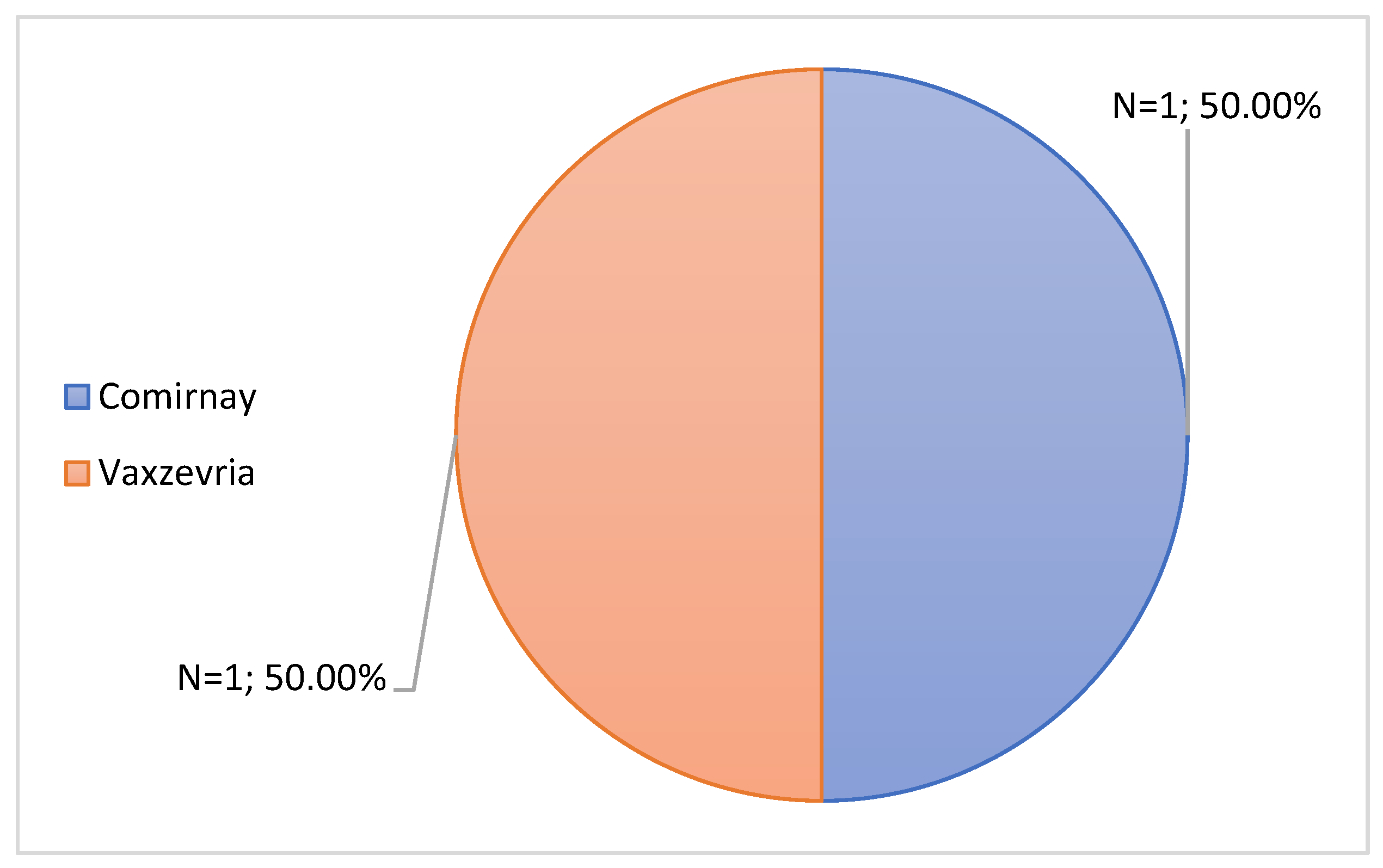1. Introduction
Coronavirus Disease 2019 (COVID-19) is an acute respiratory disease caused by the severe acute respiratory syndrome coronavirus 2 (SARS-CoV-2), which first emerged in Wuhan in December 2019. Its transmission occurs by droplets, respiratory secretions and direct contact [
1,
2].
As the virus has a rapid spread, it has become a serious public health emergency [
2]. Given that vaccination can be used to prevent infections or reduce the seriousness of a disease, some strategies were studied to generate vaccines against the new coronavirus, including vaccines based on DNA and RNA [
3,
4].
Nucleic acid vaccines consist of mRNA with information against coronavirus-specific structural proteins and do not contain any viral proteins capable of causing disease. The mRNA is taken up by cells and translated into a viral antigen, the spike protein. When recognized by the immune system as something foreign, antibodies are produced, and T cells are activated to attack the protein. If the vaccinated person later comes into contact with coronavirus, their immune system will recognize the spike protein and be ready to defend itself [
5,
6,
7,
8,
9]. In the European Union (EU), during the study period, 2 mRNA-based vaccines were authorized by the European Medicines Agency (EMA): Comirnaty
® and Spikevax
® [
7,
8,
9].
In addition to mRNA vaccines, there is another type of vaccine approved for immunization against COVID-19: vaccines with a viral vector without the ability to replicate. This type of vaccine is produced from another virus (e.g., adenovirus) that has been modified to contain information regarding the virus of interest, which will be delivered to human cells. The viral vector is a harmless virus and different from coronavirus, so it does not cause the disease. It enters human cells and releases the gene that encodes the spike protein present in SARS-CoV-2. It then uses the cell’s machinery to produce this glycoprotein which, when recognized by the immune system, leads to the production of antibodies and activation of T cells, as is in nucleic acid vaccines [
10,
11,
12,
13]. In the EU, during the study period, two vaccines based on viral vectors were authorized by the EMA: Vaxzevria
® and Jcovden
® [
7,
12,
13].
Although medicines are essential elements in the treatment of pathologies, diagnosis and prevention, they also have risks. Thus, due to the fact that there is a limited knowledge of the therapeutic profile of some drugs, it is important to continue to monitor their safety after marketing, through several available methodologies, one of which is the notification of adverse drug reactions (ADRs) to the National Systems of Pharmacovigilance (NPS), present around the world, and created in order to monitor the safety of medicines. The NPS cover all information related to ADRs and guarantee the safety of users who have contact with medicines, especially medicines recently introduced on the market. This is the case of vaccines used to immunize against COVID-19 [
14,
15].
In 1992, the SNF was created in Portugal, currently coordinated by INFARMED, I.P. In the early 2000s, the SNF was decentralized into 4 Regional Pharmacovigilance Units (RPU)-Norte, Centro, Sul and Açores-, with the aim of publicizing the system and promoting notification, bringing the system closer to health professionals and promote the involvement of university centres. Since 2017, the number of RPUs in the SNF increased, and there are currently 10 covering different areas in the country. The RPU of Beira Interior is placed at the University of Beira Interior, in the interior of Portugal, covers the districts of Castelo Branco, Viseu and Guarda and involves some under reporting [
16,
17].
When the appearance of ADRs is suspected, the process of spontaneous notification through an online or paper form or by telephone becomes important. Spontaneous reporting is a voluntary pharmacovigilance methodology, which consists of reporting an ADR associated with a particular drug and a patient, which can be by the patient, a family member or a healthcare professional. Spontaneous reporting makes it possible to detect ADRs that occur rarely or unexpectedly, generating an alert signal for subsequent epidemiological studies [
16].
Therefore, pharmacovigilance, a science involved in the detection, evaluation and prevention of ADRs, through the methodology of spontaneous reporting is an essential step to assess the safety of vaccines used in the immunization against COVID-19 [
17,
18,
19,
20].
Thus, this study had two objectives. The first objective was to characterize the ADRs associated with vaccines used in the immunization against COVID-19, notified in the region covered by the Regional Pharmacovigilance Unit of Beira Interior, in Portugal. The second objective was to compare the results obtained with the safety data from studies carried out in other countries around the world. This period was the subject of study since it was the initial period in which the vaccines authorized in the EU began to be administered to the Portuguese population.
4. Discussion
This study allowed the characterization of the notifications of ADRs associated with vaccines used in the immunization against COVID-19, notified to the Pharmacovigilance Unit of Beira Interior, in Portugal, in the time period between December 2020 and December 2021.
Initially, the type of notifier who submitted the notification was analyzed. Through data analysis, it was found that pharmacists had the highest notification rate. The user or other non-healthcare professional also contributed to improving the safety profile of vaccines, followed later by physicians. According to the graph “Evolution of ADR Notifications received in the SNF, by origin, 1992–2021”, made available by INFARMED, over the years, the biggest notifier of ADRs has been the pharmaceutical industry [
30]. In the year 2021, the industry was the biggest notifier, followed by physicians and later by pharmacists. The results obtained in this study are not in accordance with the INFARMED graph, presenting the pharmacist as the greatest notifier of ADRs associated with vaccines used in the immunization against COVID-19. This is related to the fact that the pharmaceutical services of 2 hospital centers established pharmacovigilance protocols and were later involved in collecting information from patients after the administration of these vaccines, thus increasing the notification rate obtained by pharmacists. However, in general, the results obtained in the study support the fact that healthcare professionals are increasingly aware of the need to notify suspected ADRs, in order to improve the safety profile of medicines. As mentioned in the Notifier Characterization section, the fact that this study focused only on a regional unit explains why we did not obtain ADRs notified by the pharmaceutical industry, as these professionals notify them directly on the ADR portal, with no specific region being assigned to them.
Regarding the district of origin of the notification, it was found that most notifications presented Castelo Branco as the district of origin, followed by Viseu and finally Guarda.
Among the analyzed data, the age group with the highest notification rate, among the groups considered, was the group from 25 to 49 years old, followed by patients aged between 50 and 64 years old. These data are in accordance with the document “Pharmacovigilance Report: Monitoring the safety of vaccines against COVID-19 in Portugal. Data received until 01/31/2022.”, which indicates that the age groups 25 to 49 years old and 50 to 64 years old had the highest number of ADR notifications at the national level [
29]. This fact may be due to the greater number of vaccines being administered in these two age groups, in addition to being age groups with greater ability to recognize an ADR. It is also important to point out that, according to the data referring to the resident population in Portugal by age group, these are the age groups with the largest population [
31]. Regarding gender, the population was mostly female, and these data are supported by the aforementioned document [
29]. Generally, the female gender is the one that most notified to any drug, due to the greater susceptibility to develop ADRs, compared to the male gender, probably due to the physiological differences between both sexes. Additionally, it may be related to women’s greater attention to their health and signals developed by their body [
29,
32,
33]. International studies also confirm the aforementioned data regarding the age groups and gender with the highest notification rates of vaccine-associated ADRs [
34,
35].
Subsequently, ADRs were analyzed according to the type and brand of the vaccine administered. In this study, during the analysis period, mRNA vaccines were the most notified. Most of the notifications submitted were associated with the Comirnaty vaccine, followed by the Vaxzevria vaccine. In fact, these data were in agreement with the INFARMED Pharmacovigilance Report, which indicates that the majority of ADRs notified in Portugal correspond to mRNA vaccines [
29]. It should be noted that these results may be due to the fact that these were the most administered vaccines in Portugal as well as in the EU and the United States [
36,
37]. The same report mentions that the vaccine with the highest number of ADR notifications was Comirnaty, followed by the Vaxzevria vaccine, which reinforces the data in
Figure 5 available in
Section 3.3.1. of the results [
29]. These data are corroborated by EMA data, which indicate that these were also the most ADR vaccines reported in Europe [
38]. According to data from the Centers for Disease Control and Prevention, the Comirnaty vaccine was the vaccine with the most ADRs reported in the United States [
39].
The three most frequently notified SOC groups were “General disorders and administration site conditions”, “Nervous system disorders”, and “Musculoskeletal and connective tissue disorders”. Thus, with regard to “General disorders and administration site changes”, it is easy to see why they represented the most frequent SOC group, given that this group encompassed non-specific symptoms that affect various sites in the body, such as general malaise or fatigue, as well as ADRs frequently associated with the administration of any vaccine, such as pain, swelling, itching or bruising at the injection site. These signs are usually mild and transient. As for the second group, “Nervous System Diseases”, they included symptoms such as headaches, migraines and convulsions. The third most notified group was “Musculoskeletal and connective tissue disorders”, which included myalgias, arthralgias and pain in the extremities. It is easy to understand why it was among the three most notified groups, as SARS-CoV-2 binds to host cells through the spike glycoprotein, through the ACE2 receptor [
40]. This receptor is found in the epithelial cells of the pulmonary alveoli and in the enterocytes of the small intestine, as well as in the skeletal muscle and central nervous system, which may be related to myalgias. Additionally, another phenomenon associated with myalgias is the “cytokine storm”, in which interleukin-6 plays a key role in inducing the production of prostaglandin E2, associated with inflammation and pain [
40]. The vaccines used to immunize against COVID-19, despite not containing the virus in their constitution, have information that encodes the spike protein, recognized by the immune system, and capable of causing an inflammatory response, through a large production of pro-inflammatory cytokines, which leads to the appearance of myalgias and other musculoskeletal symptoms [
41,
42]. These data are in accordance with the aforementioned Pharmacovigilance Report [
29]. According to the document “Rapporto sulla Sorveglianza dei vaccini anti-COVID-19”, issued by the Agenzia italiana del farmaco, the three most frequently notified SOC groups were the “General disorders and administration site conditions”, “Nervous system disorders”, and “Musculoskeletal and connective tissue disorders” which are in accordance with the results obtained through this study [
43].
Following the analysis by SOC groups, the ADRs were classified according to the PT terms. The three most frequently notified ADRs were “Reaction at or around the injection site”, “Myalgias”, and “Headache”. These data are in agreement with the data from the most frequently notified SOC groups referred to in the previous paragraph (“General disorders and administration site disorders”, “Nervous System Disorders”, and “Musculoskeletal and connective tissue disorders”). The explanation for the ADR “Reaction at or around the injection site” being among the three most frequently reported ADRs is related to the way in which the vaccines are administered. This group belongs to the SOC group “General disorders and administration site conditions”, referred in the previous paragraph. “Headache” is among the three most reported ADRs, however the mechanism by which it occurs remains unclear. Some authors suggest that “Headache” may be due to a direct activation of the trigeminal vascular system, which consists of nerve fibers originating from the trigeminal nerve that innervate cerebral blood vessels. Additionally, another phenomenon possibly associated with “Headaches” is the “cytokine storm”, associated with inflammation and pain [
44]. These data are in agreement with the INFARMED Pharmacovigilance Report, which mentions “Headache”, “Myalgias” and “Pain at the injection site” among the most frequently notified ADRs. This report also mentions that “Pyrexia” is the most prominent ADR, something that was not verified through the data under study [
29]. However, this is a term that also has a high notification rate, ranking 4th in
Table 3 of
Section 3.3.2. It is easy to understand why it had a high notification rate, taking into account that it is characterized by an immune system response to a foreign body introduced into our system, as is the case with the vaccine [
39,
40]. These data are also corroborated by studies carried out in other countries, which indicate that “Reaction at or around the injection site”, “Myalgias”, “Pyrexia” and “Headache” are among the ADRs most commonly associated with vaccines [
45,
46,
47]. During the study period, several countries suspended or restricted the use of vaccines to certain populations due to the emergence of rare adverse reactions [
48,
49,
50].
The notified ADRs were compared with the SmPCs of the respective vaccines, showing that most RAMs were already described. Regarding the degree of causality, most ADRs were classified as “Possible” or “Probable”, followed by the degree “Unlikely” and the degree “Unclassifiable”. Although ADRs not described in the SmPCs represent a low percentage, it is crucial that they receive a degree of importance, especially in those in which it was possible to conclude the degree of causality as “Possible” and “Probable”, since they allow updating the safety profile of each vaccine and consequently its SmPCs, thus reinforcing the importance of reporting ADRs.
Regarding seriousness, 20.34% of ADRs were considered serious ADRs, most of which were associated with the Comirnaty vaccine. In fact, these data are in agreement with the INFARMED Pharmacovigilance Report, which indicates that the majority of ADRs associated with vaccines used in the immunization against COVID-19 correspond to non-serious ADRs [
29]. According to the document “Rapporto sulla Sorveglianza dei vaccini anti-COVID-19”, most ADRs were classified as non-serious, which corroborates the results obtained in this study. However, this document indicates that the vaccine most associated with serious reactions was Spikevax, which is not in agreement with the results obtained in this study [
43]. Our results may be due to the fact that Comirnaty was the most administered vaccine in Portugal [
29]. Even so, there is a large percentage of serious notifications, which again reinforces the importance of healthcare professionals and users to carry out the notifications of ADRs.
The seriousness criteria with the highest rate were the “Clinically important” criteria, followed by the seriousness criteria “Disability”, “Hospitalization”, “Life risk” and “Death”. It is important to note that there were notifications in which the notifier had selected more than one seriousness criterion. These data are in accordance with the documents “Pharmacovigilance Report: Monitoring the safety of vaccines against COVID-19 in Portugal. Data received until 01/31/2022” and “Rapporto sulla Sorveglianza dei vaccini anti-COVID-19”, which indicates that the seriousness criteria that stands out the most is “Clinically important”, with the criteria “Life Risk” and “Death” being less prominent [
29,
43]. The Comirnaty vaccine was responsible for the most hospitalizations as well as for half of the cases associated with the “Life Risk”. In fact, these results may be due to the fact that this was the most administered vaccine in Portugal as well as in the EU and in the United States [
36,
37]. Regarding the seriousness criteria “Death”, the associated vaccines were Comirnaty and Vaxzevria, with patients aged 86 and 74 years, respectively, both of whom had a history of acute myocardial infarction.
Most of the ADRs notified progressed to cure. In total, there were 2 notifications that progressed to death, of which 5 terms were on the IME list, most of the terms referred to “Cardiac disorders”. These 2 notifications corresponded to patients aged 74 and 86 years, with a history of acute myocardial infarction as well as in the presence of cardiovascular risk factors, among which diabetes mellitus, arterial hypertension, obesity and dyslipidemia stand out. Regarding the notified ADRs, the regulatory authority classified them with a degree of causality “Improbable”, based on the history that the patients had, which meant that the vaccines were not the cause of death for both patients. These data are in agreement with several studies that indicated that the cases of death that occurred in patients after vaccination against COVID-19 were not related to the vaccines administered, being nothing more than mere coincidence [
51].
4.1. Limitations
This study had some limitations, among which we can highlight the rate of under reporting of suspected ADRs, i.e., not all ADRs that occurred were notified to the National Pharmacovigilance System, which may have occurred, for example, due to lack of time or ignorance regarding the existence of the “Portal RAM” [
16,
17]. Another limitation is related to the fact that some notifications presented a lack of information, making their study difficult. Additionally, the fact that the Comirnaty vaccine is the most administered vaccine in Portugal, leading to the majority of ADRs reported being associated with this vaccine, may have biased the results obtained, since the vaccines under study were not administered in the same number of patients, making it more difficult to compare the results.
4.2. Strengths of Study
The strengths of our study included a large sample size in which it was possible to characterize several parameters associated with the reported ADRs. Additionally, it was the first study carried out in Portugal, to our knowledge, over a long period involving data corresponding to the first, second and third doses.



